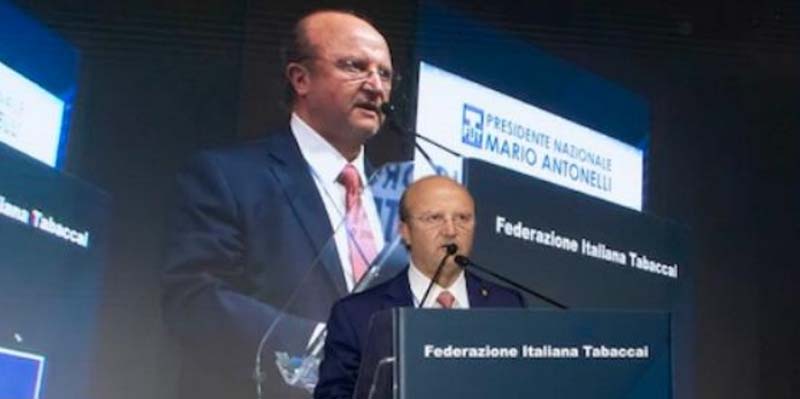Reshaping of the Vape E-Cigarette Retail: Brick-and-Mortar Stores Making Way for Vape E-Cigarette Shops in European countries.
Are many vape e-cigarette manufacturers working hard for the vape selling channels?
In recent days, the remarks of Mario Antonelli, the chairman of an Italian tobacco company, have attracted attention. He mentioned that "shops exclusively selling vape electronic cigarettes are giving way to tobacco merchants."

In the Italian vape market, there are three distribution channels: vape e-cigarette specialty stores, online vaping stores, and tobacco shops. Despite fierce competition, the latter remains the preferred purchasing location for about 60% of consumers of these products. This is a significant percentage that cannot be ignored.
The popularity of vape e-cigarettes has also caused a change in perspective for Mario Antonelli, the Chairman of the Italian Federation of Tobacco Merchants. He states, "E-cigarettes also have ample space, they are the new generation of tobacco products, and thousands of tobacco merchants are forced to deal with them. Despite initial skepticism, over the years, support for vape e-cigarettes has become dominant, to the point that even the small trade association that initially supported their spread has now joined the ranks of vape e-cigarettes." This indicates that in Italy, vape e-cigarettes are dominating the market.
Let's recap a few points:
Firstly, Overseas vape e-cigarette channels are diversifying.
Rather than saying they are diversifying, it is more accurate to say they are becoming more diversified. The commercialization process of the e-cigarette market has given the retail industry more choices.
In some European countries, you will find that the sales of e-cigarettes in mainstream specialty stores are not as high as those in other retail channels.
For example, in the UK, e-cigarette specialty stores are scattered, but convenience stores, chain supermarkets, and grocery stores all sell e-cigarettes, and they are concentrated. The breadth of their retail is much greater than that of so-called specialty stores, making it easier for buyers to access them.
From the perspective of channels in these European countries, electronic cigarettes are generally regulated as part of the tobacco industry, so they are closely associated with tobacco. At the same time, due to the disposable nature of electronic cigarettes, their distribution channels are no longer limited to so-called specialty stores, and other retail channels for electronic cigarettes are rapidly emerging.
Secondly, Is the monopoly model of electronic cigarettes in Europe outdated or not yet in time?
The question remains whether the monopoly model of electronic cigarettes in these overseas European countries is outdated or not yet in time.
The monopoly of electronic cigarettes may be more convenient in terms of management, with some countries even having licensed e-cigarette stores. However, currently, most European countries do not require a license for the retail of electronic cigarettes, so the monopoly model has not yet gained traction.
Looking at the situation in China, electronic cigarettes have entered the monopoly model, and all e-cigarette businesses must be licensed.
Nowadays, it seems that the European electronic cigarette market is experiencing a special storm in the retail industry. The question is whether retail is encroaching on the business of e-cigarette monopoly stores or if the monopoly stores are replacing retail and other distribution channels' market share. However, at present, it is evident that a large number of electronic cigarette retail channels are dominating the mainstream market for electronic cigarette sales.
Thirdly, Major retailers are transitioning into e-cigarette distribution in some European countries.
For example, Supreme, a leading e-cigarette distributor in the UK, used to be a retail giant for other products such as batteries, lighting, and household consumer goods. It is now one of the leading e-cigarette distributors in the UK. The company has over 10,000 retail stores and more than 3,300 active retail partners, including major supermarket chains like Tesco, Morrison, One Stop, and WHSmith Travel. This shows that the overseas e-cigarette consumption trend is fueling a transformation in the local retail industry.
In fact, research conducted in markets such as London and Manchester in the UK has found that many wholesalers of mobile phones, home appliances, smart hardware, clothing, and sports equipment are considering transitioning into the e-cigarette business. E-cigarettes have quickly captured the market with their disposable nature, gaining a solid market share. This is the attractiveness of the e-cigarette market and it brings new opportunities for the global retail industry.
Italian tobacco merchants who are eyeing this cake also said, "Since e-cigarettes do not have mandatory prices like traditional tobacco, we hope that the industry can jointly establish standards to ensure that this retail store has the lowest profit level and the lowest possible cost as a sacred guarantee. Because everyone, including tobacco merchants, hopes that their work can be adequately rewarded. This is a matter of dignity in business."
Currently, some European countries are providing retail space for e-cigarette devices, but at the same time, they also need the utmost professionalism and innovative solutions to meet the constantly changing market demands and to combat illegal channels and attacks targeting underage consumers, in order to achieve a safer future for public health.
Of course, in the current globalization process of vaping e-cigarettes, vape brand manufacturers need to expand their customer base and have multiple choices for vaping distribution channels, seeking diversification. However, it is important to find more precise ways to expand the customer base!
